Home>Our Work>Conservation / Stewardship>E.coli Monitoring>E.Coli Monitoring - Part 1
E.Coli Monitoring - Part 1
Two Rivers Coalition has been conducting E. coli testing in both the Black River and Paw Paw River watersheds since 2017. That testing is expensive and has only been possible thanks to the generosity of the following donors:
Jimmy Scott family, Freshwater Future, Van Buren Conservation District, and Dick and Carol Purdy
Before we present the maps and graphs of the test results, we need to explain our methodology. We chose 10 sites in the Black River watershed and 19 sites in the Paw Paw River watershed to test twice a year. We test each site once every year when there has been no appreciable rain for at least 3 days, and we call this "Dry Event testing". We also test each site once per year within 24 hours after a one-half inch rain. We call this "Wet Event testing".
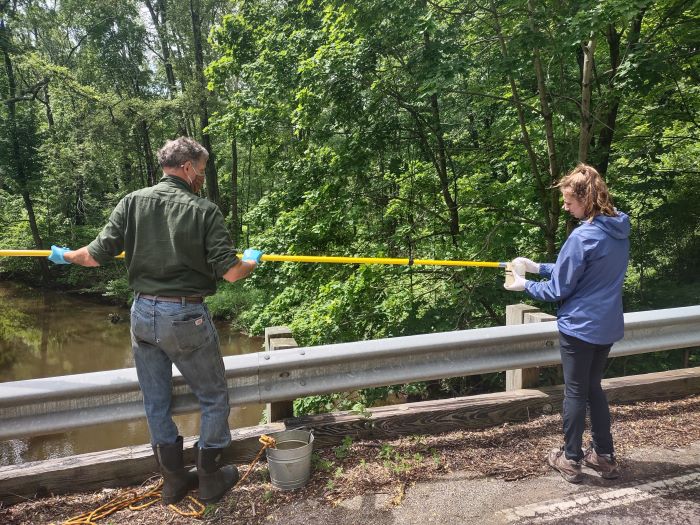
Testing during both Dry Events and Wet Events allows us to get a sense of what role manure run-off from agriculture fields may be playing. An important aspect of our testing protocol is that we take duplicate water samples from each site. The first is used to determine the overall level of E.coli present at the time of sampling; the second to determine the source. The first sample is sent to a local lab which tells us within a few days whether E. coli was present in the sample and in what amount. However, this type of lab analysis does not tell us the source of the E. coli. DNA testing could be used on the second sample to determine the specific source or sources of E.coli, i.e., whether the E. coli was of human origin, or cow, or even geese (to name a few of the most likely sources).
DNA testing, while desirable is, unfortunately, currently beyond our means. We have, however, found a suitable alternative that yields valuable information about the source: canine testing. That’s right. We send the second sample from sites reporting an unacceptably high level of E.coli to an outfit that uses highly trained dogs to sniff the collected content. If the dogs alert, we know that those water samples have the smells of human sewage present. TRC believes it is reasonable to assume that high E. coli levels in water samples with human sewage present is caused by human waste. Thus, TRC is able to compile data on not only the total E.coli level, but whether or not human sewage is a contributor.
Test results are presented in the maps below which can be made larger by clicking on them. For each watershed, we have color-coded the 4-year average E.coli cfu levels for each site for both Dry Event and Wet Event testing. A green dot indicates the 4-year average is less than 300 cfu (colony-forming units per milliliter). The United States E.P.A. has set a standard that does not allow total body immersion (think swimming) in water over 300 cfu.
A yellow dot indicates the 4-year average was between 300 and 1,000 cfu. The E.P.A. has set a standard of no partial body contact (think wading or paddling) in water over 1,000 cfu. A red dot indicates where the 4-year average was over 1,000.
We have also generated maps that just show the results of canine testing in the year 2020. Remember, all the sites that are submitted for canine testing have already had a lab test showing elevated E. coli levels. A green dot means no human sewage was detected in 2020. A yellow dot indicates the canine testing was inconclusive. An orange dot indicates that human sewage was detected but in a lesser amount. Usually, this means that a dog with a more sensitive nose alerted while another dog that was less sensitive did not alert. A red dot means human sewage was definitely detected.
Finally, the data is presented graphically in a box plot with error bars showing the statistical validity of the sample size. We are very thankful to Kyle Boone and the Pokagon Band of Potawatomi DNR for crunching the data and preparing the maps and graphs.
An important caveat: although we believe that our testing over the last 4 years reveals important findings and trends, it does not meet the testing protocol for E.G.L.E. and has no legal weight. We have conducted this testing and are now publishing the results to let the general public know about the problem of E. coli in our streams and rivers and to hopefully encourage further efforts to reduce E. coli contamination in our waterways. It is also important to understand that while there may be a correlation between beach closures on Lake Michigan and high E. coli levels in the rivers that empty into Lake Michigan, TRC is not taking any position on the safety of swimming at public beaches. County health departments by law have the duty to test the water at beaches throughout the season and order closure of beaches that fail to meet standards set by the state.
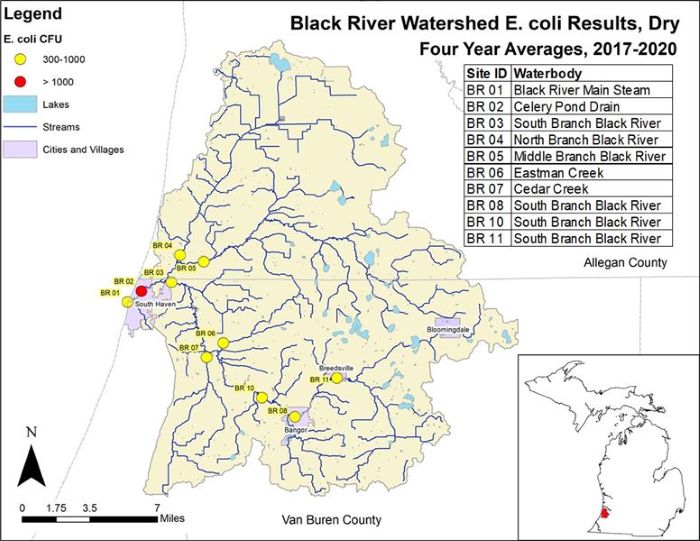
The above map of the Black River watershed contains the 4-year averages for dry event testing. It shows that 9 out of 10 sites tested in the Black River watershed exceeded the full-body immersion standard. This means they would be considered unsafe for swimming. One site (outlet of Phoenix Drain into Celery Pond) exceeded the partial body contact standard. This means it would be considered unsafe for wading or recreational activity such as paddling.
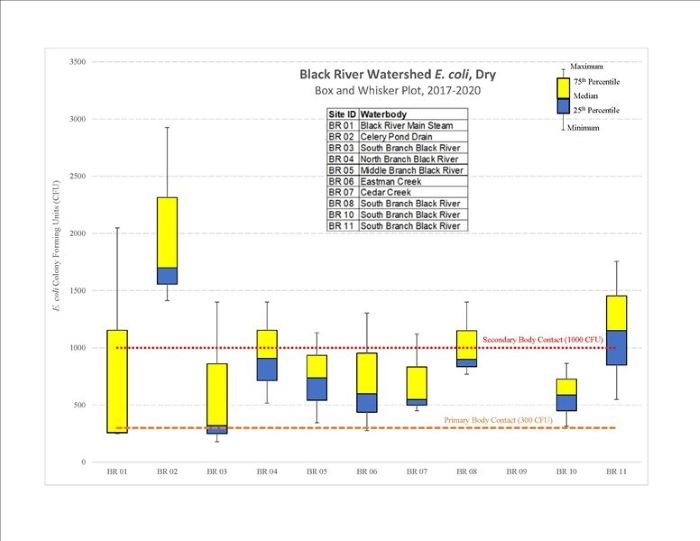
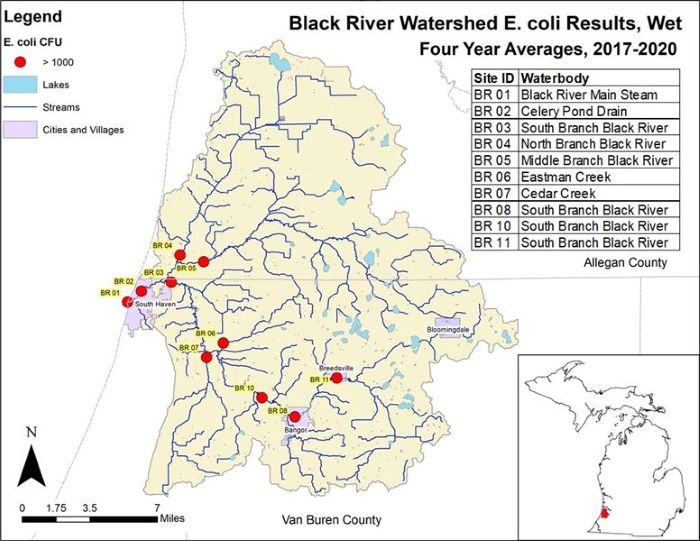
The above map of the Black River watershed contains the 4-year averages for wet event testing. It shows that all ten sites exceeded the partial body contact standard. We believe this means that it may be unsafe to have direct contact with water in streams or rivers anywhere in the Black River watershed after a significant rain.
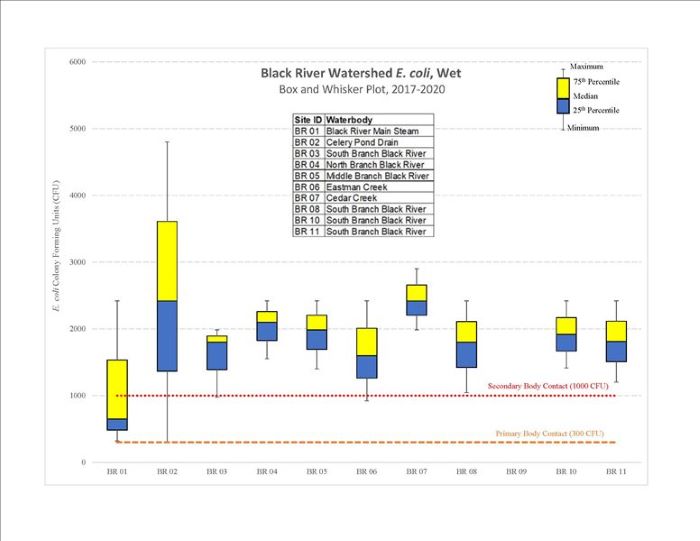
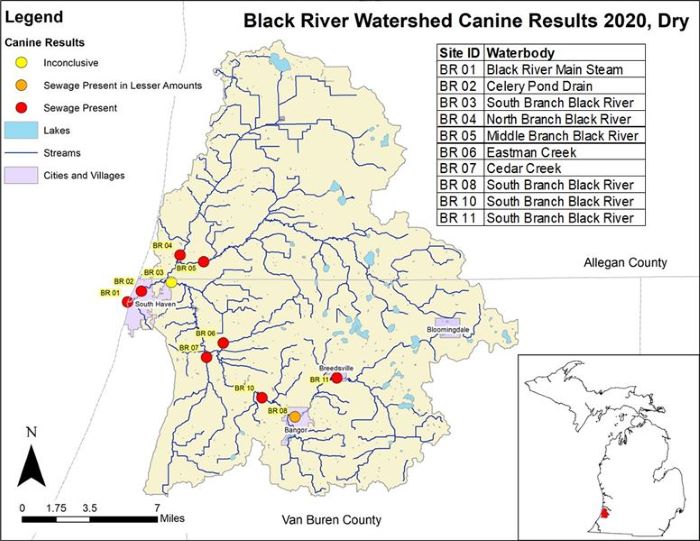
The above map of the Black River watershed shows the results of canine testing in 2020 for the presence of human sewage when there had been no rain for at least three days. Eight sites showed a strong presence of human sewage while one site (City of Bangor) showed human sewage in a lesser amount. One other site was inconclusive.
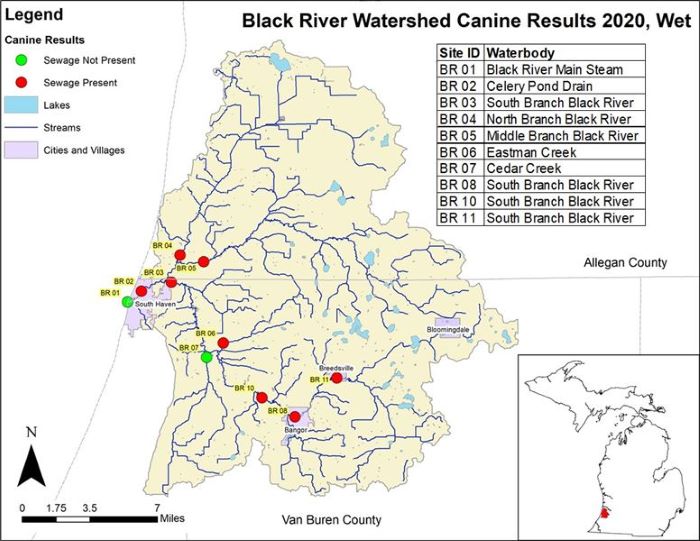
The above map of the Black River watershed again shows the results of canine testing for the presence of human sewage in 2020, but this time after a significant rain event. Again, eight sites showed a strong presence of human sewage. Two sites (Black River Park in South Haven and Cedar Creek) indicated no presence of human sewage, even though the duplicate samples tested by the lab did show high levels of E. coli.
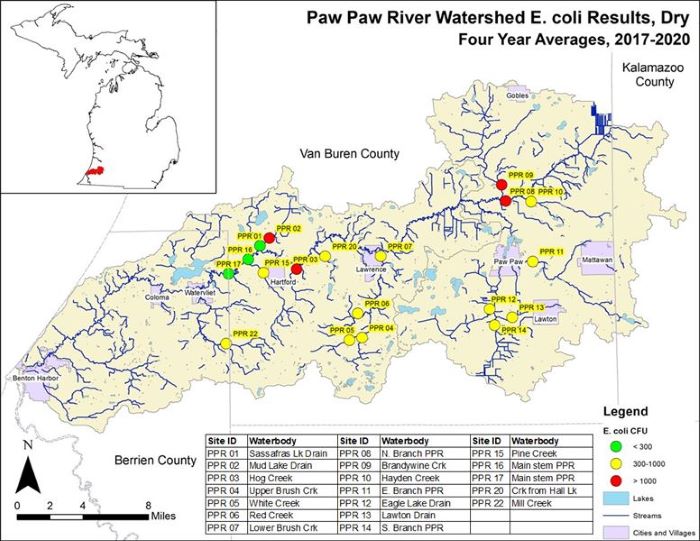
We have now switched watersheds. The above map of the Paw Paw River watershed shows the 4-year averages for dry event testing. Twelve sites exceeded the total body contact threshold. Four additional sites exceeded the partial body contact threshold. Only three sites met the standard for safe recreational use (two sites on the main stem of the river and one site on Sassafras Lake Drain).
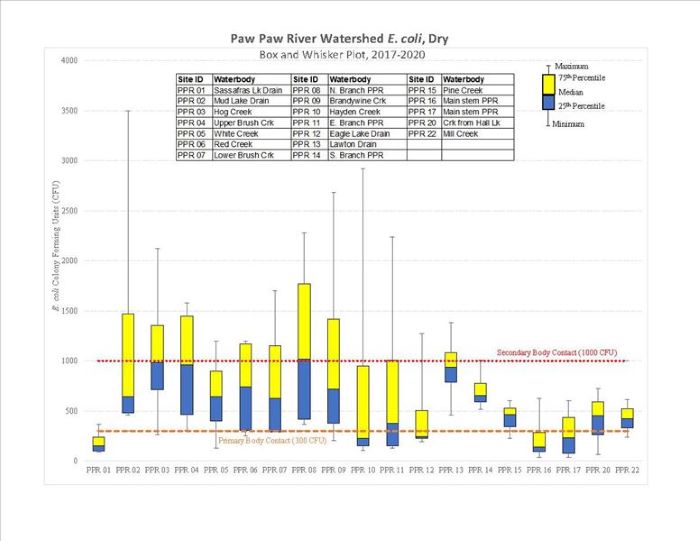
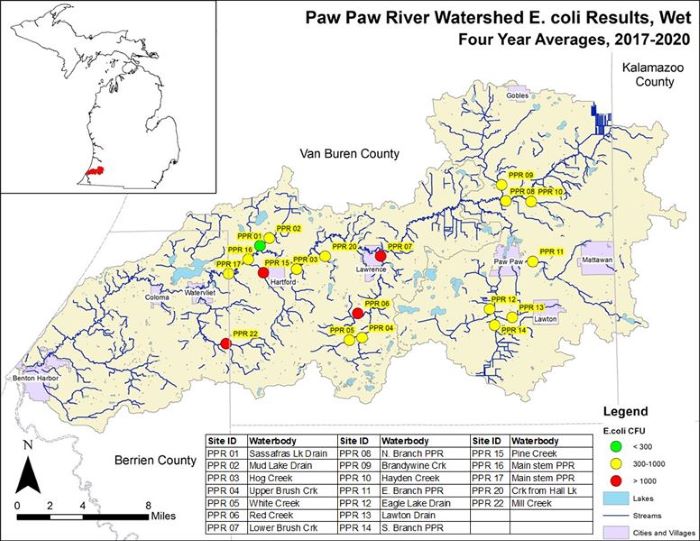
The above map contains the 4-year averages for wet event testing in the Paw Paw River watershed. It shows 14 sites exceeded the full-body contact threshold. An additional four sites exceeded the partial body contact threshold. Only one site (again Sassafras Lake Drain) met the recreational use standard.
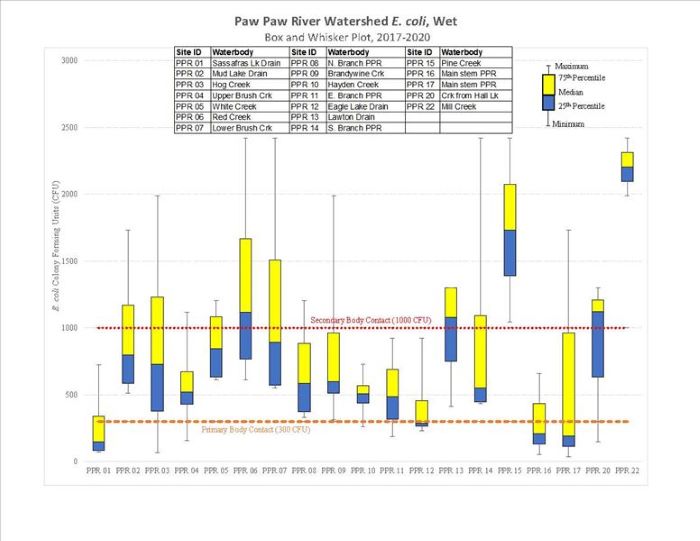
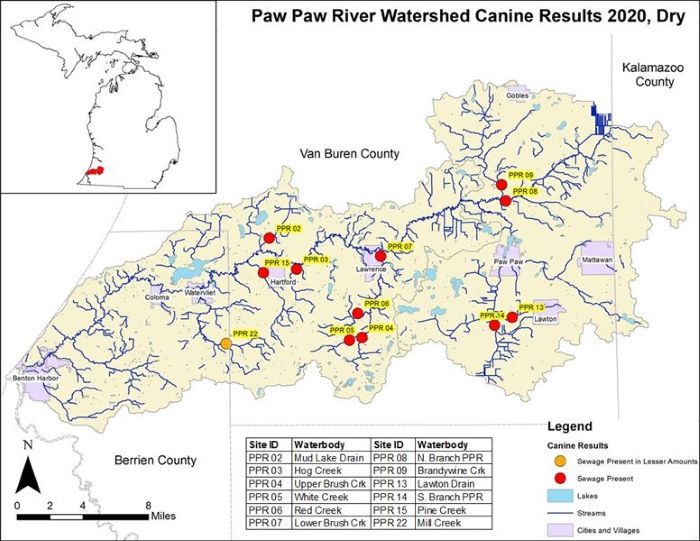
The above map of the Paw Paw River watershed shows the results of canine testing for the presence of human sewage in 2020 when there had been no rain for at least three days. Out of the 12 sites where the lab had detected high levels of E. coli, duplicate samples from 11 sites showed a strong presence of human sewage. One site (Mill Creek in Berrien County) showed the presence of human sewage in a lesser amount.
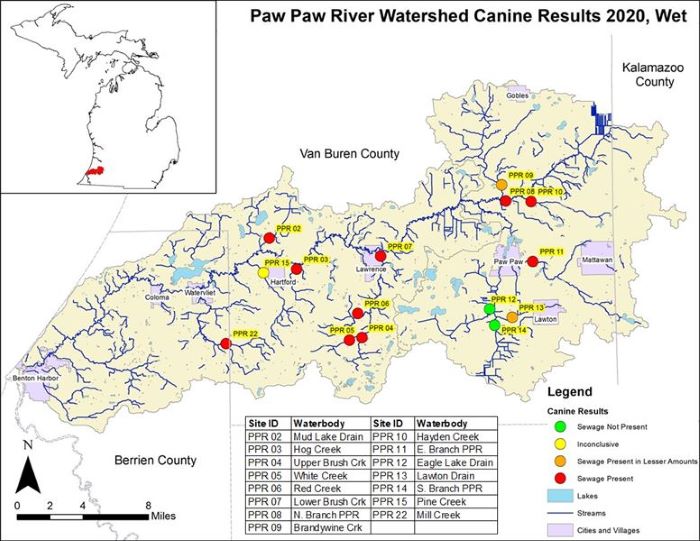
The above map of the Paw Paw River watershed shows the results of canine testing for the presence of human sewage in 2020 when there had been a significant rain event. Out of 15 sites where the lab had detected high levels of E. coli, duplicate samples from 10 sites showed the strong presence of human sewage. Two other sites showed the presence of human sewage in a lesser amount. Two sites, although containing high levels of E. coli, showed no presence of human sewage. One site was inconclusive.

